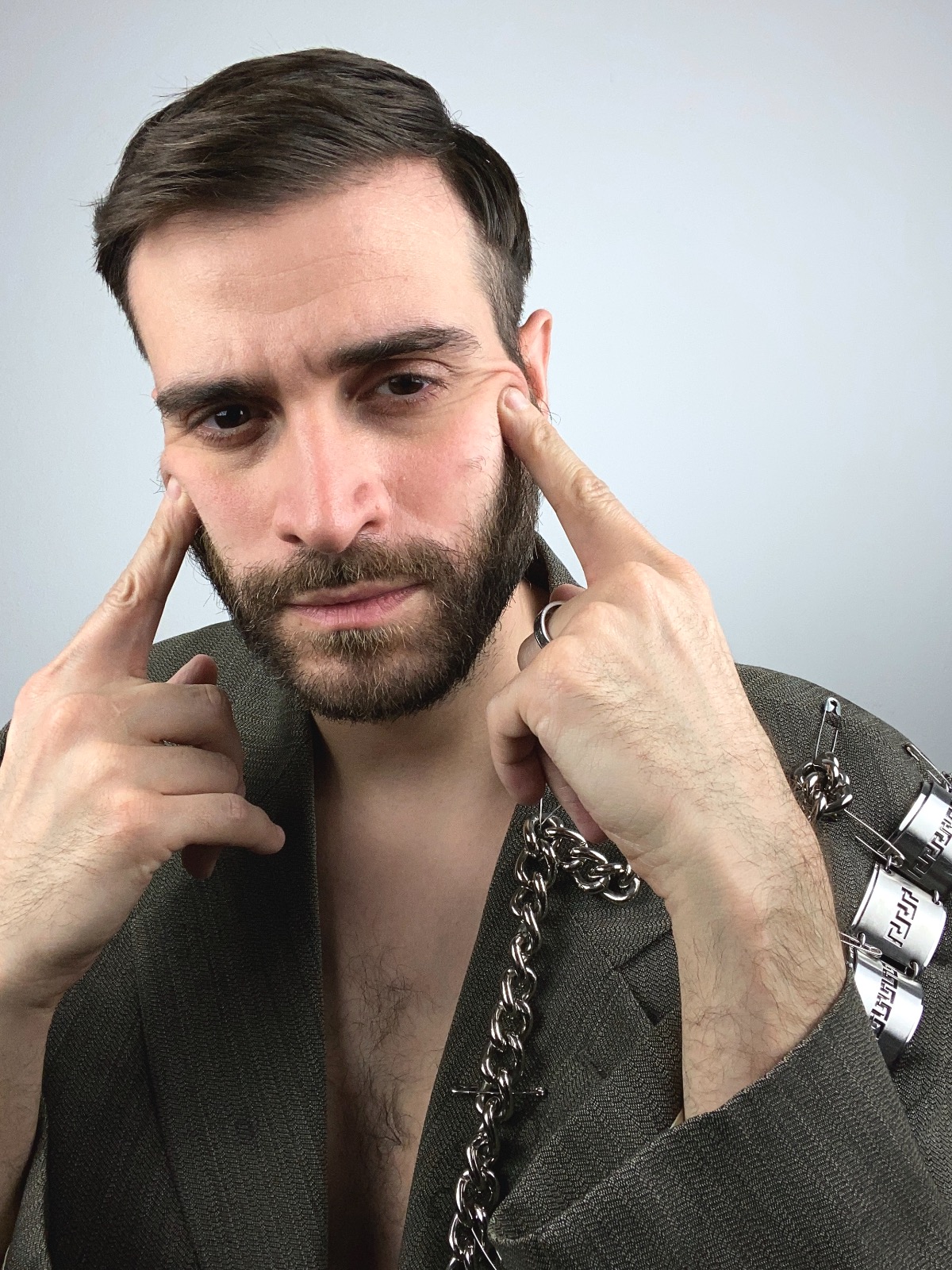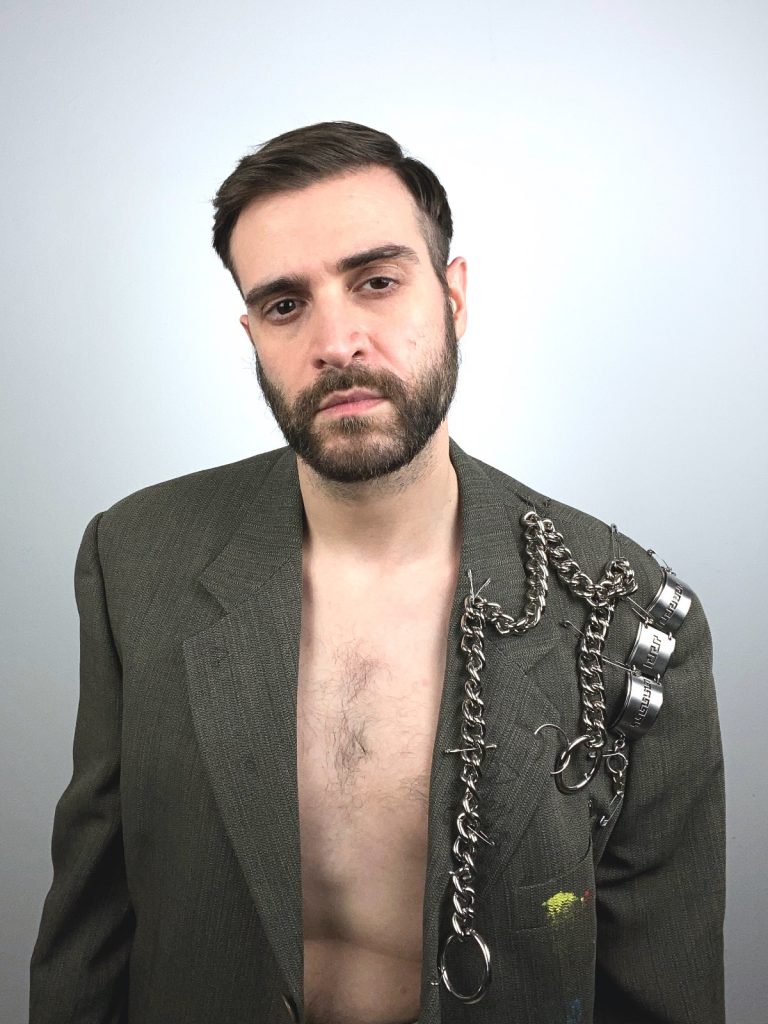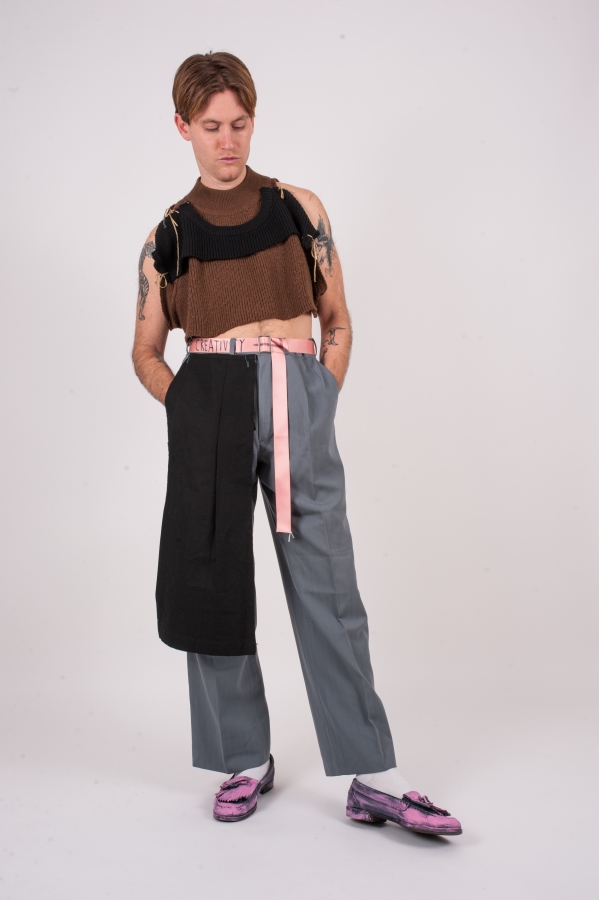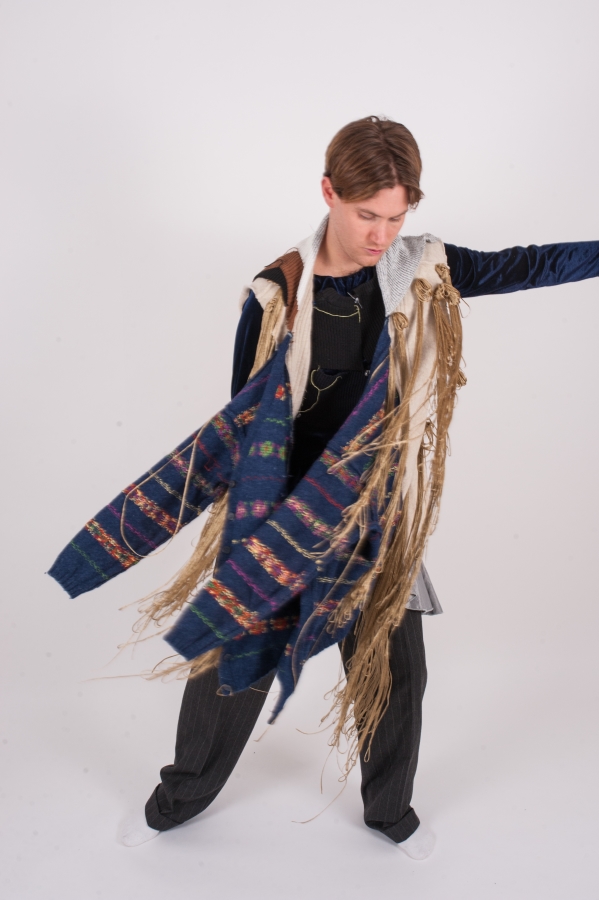The designer who destroys and recreates: not just recycling and upcycling, but an hymn to freedom.
Simon Cracker creates, imagines, tells. Into his art there is nowadays’ himself, who lives, feels pain and gets emotional. There also is the child who grew up with his grandparents in the countryside near Cesena, his passion for Japan and his restlessness.
The research on ecology, his battle against waste, the rejection of fashion stereotypes and the complete carelessness about aesthetic, sexual and seasonal labels: all of this is Simon Cracker.
Have you always felt this empathy for your collections – like the S/S 2021 “Alba”, which is dedicated to your grandmother?
This goes to my childhood. I’ve grown up with my grandparents and I’ve always looked at my own life through their glass. My grandma was a housewife and spoiled me madly, my grandpa was a house painter but in his spare time he used to paint pictures. I loved going with him at work because I could walk around strangers’ houses trying to guess how they looked and imagine who they were only through their objects.
It was a game and now I keep on playing the same through my creations; I take textiles and yarns from stocks which are about to get thrown away and have already lived their own life, I restyle and recycle them. It follows the uniqueness of every piece, coming from a limited quantity of the same material. It was different for the S/S 2021 collection, which I named “Alba”, like my grandmother. I produced new fabrics on which I printed my grandmother’s pictures and grandfather’s paintings… I felt I had to act like this in this case, it was like returning to their arms.
I am not attached to things but my collections are exactly my outburst, that’s why they are so important for me. They are that part of me I want to get rid of, the good things, the bad ones, memories, illness, traumas. I use my art as a therapy, like a relief valve. Sometimes it’s nice to see them again, but it’s often painful.
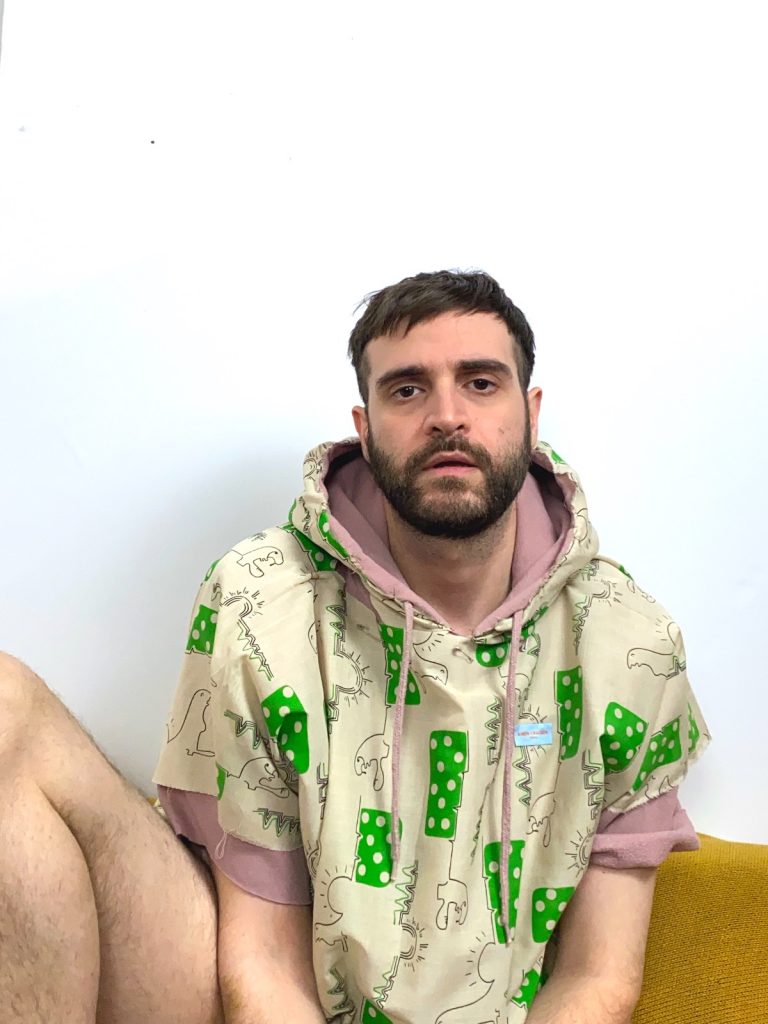
Do you think people understand the introspective value behind your art or is it something completely personal?
I can’t tell. I think in some cases someone understood the message and could see further. Some things have a more evident and explicit sense, others are harder to perceive. Like, some T-shirts having wounds and bruises over them, it’s clear we’re talking about pain and sufferance.
But, for instance, my collection with stuffed animals and Hello Kitty all over the items could be seen like a mere aesthetic provocation. It was hard to say there was a deep analysis about violence against women standing behind it. But I didn’t feel like unfolding it, it was totally mine.
From what you say, it seems like your vision of fashion is actually closer to art than to fashion.
I don’t really like the word fashion, to be honest. I don’t feel like belonging to this world. It feels more like something expiring, that runs out in a few months. Trendy, cool, glamour, I have a serious issue with these words. My creations don’t aim to be cool and then stop being cool in a month. I prefer to have ten people less who fall in love with my stuff, but a single one all-encompassing. Someone willing to bring a piece of me into his own life, through my item. And I want this product to live again and again, to be given away, reused, modified, but to keep on living.
Feeling so far from this world I wonder, how did your fashion journey begin?
At the beginning I was some kind of parasite in this field. I studied advertising graphics and I approached fashion working as a graphic designer for patterns and fabrics. Then I started some collabs with Polimoda in Florence, Osaka Bunka Fashion College and Central Saint Martins.
Working with fabrics allowed me to have a wide view of fashion, learning about multiple brands and styles. Most of all, I started to grow my personal taste with specific knowledge about textures and printing. Here I started loving reliefs and plastic effects, testing glues, fabrics, glitters, sequins, plastic, inks. I created some unbelievable effects; fish scales effect, gumming, wet look coating. These elements are still part of Simon Cracker’s concept.
How do you feel about the usual fashion borders? I’m talking about seasons, the split between male and female, sizes…
I don’t like limits. I want to create something that gives freedom. Freedom is the keyword. I want my items to suit different body types with one only size, loose fitting clothing for anyone to feel good. I’ve always felt like oversizing allows more control over your own body and shade, it distorts your image so much that you can feel someone new.
Upcycling is the most recognizable element in Simon Cracker’s style. Graffiti, eyes, your tags, they are the signature pattern of your line. Do you still feel like this concept is deeply yours?
For a while I actually considered to stop this, because people started to think I only reloaded vintage, but the truth is my showroom still wants it, in particular because the Japanese market asks for it. That’s why there still is some upcycling in the present collection. I think Simon Cracker should be everything I am: deconstruction, reconstruction, recycling, new stuff.
Through graffiti I have let off steam, customizing the stock leftovers I used to hunt for building my own archive. Now I am still carrying them on, but trying to find new ways to use them.
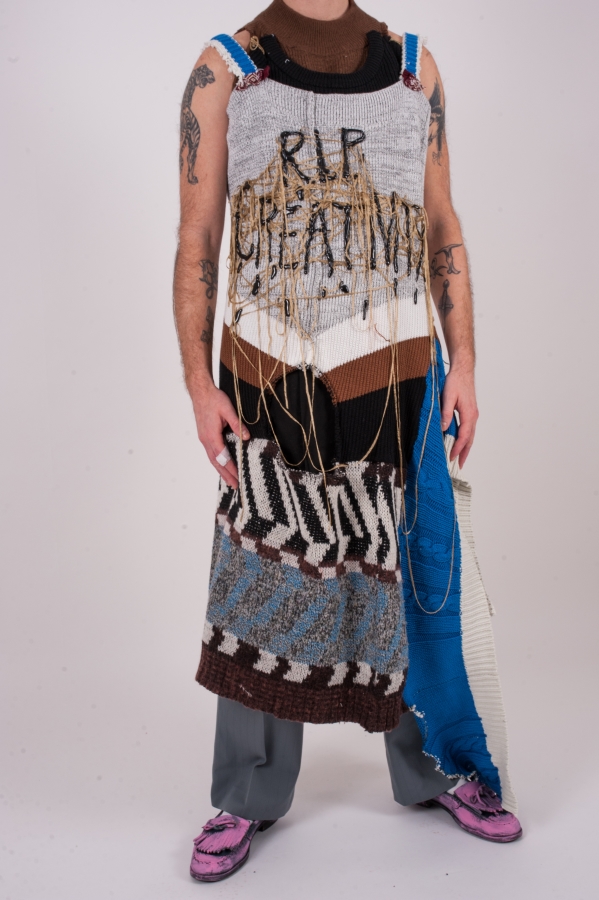
What about slogans? I saw you used them quite often, recently, embroidered on items, written on sketches and illustrations.
Yes, I used some. Creativity is dead, No budget, BASTA MODA. They came up in 2020, during quarantine, when I suffered a lot from the awareness of overproduction. We found ourselves in that historical time and I felt like everything just stopped, but at the same time we kept on producing as much as the previous years. I felt like I was choking, overwhelmed by all this stuff.
Analyzing brand strategies, I feel deeply disappointed seeing that retail products are completely disjointed from what you see during the fashion show. I believe this is just wrong, I won’t adjust to this method, I won’t follow a sales-oriented logic, careless of the core concept.
You said you sell well in Japan, you have a nourished following in China. Tell me something about your relationship with the Far East.
Japan has always been a huge source of inspiration for me: kimonos, the style, the quietness of the population, I’ve always felt a deep connection to this land, even before going there.
China is a little harder, because it’s not easy to understand what they want. The person who invested in me has chinese origins, but she has always lived in San Francisco. I’m glad she really believes in my project, she’s able to find the right keys for the market while leaving me the freedom I need over my essential choices, like the Made in Italy production.
As of the european market it’s completely different, I had to make adjustments because things I sold in Hong Kong didn’t work in the western world. From a wider perspective, it’s clear my target market is the East and we already knew it.
Your fashion shows are always some kind of happening. How important is the “experience” feature for you?
For me, the important thing is the concept to be respected in every aspect of the collection. During the pandemic, I got to carry out the perfect fashion show, the S/S 2021 “Alba”. It retraced the performances I used to make as a child with my cousin, in the countryside. The bed sheets were our curtains, the land was our stage. I came back to the fields of my childhood, with my aunts as the audience sat on their chairs, just like when I was a kid. For safety reasons, I couldn’t invite any guests but it’s been magical.
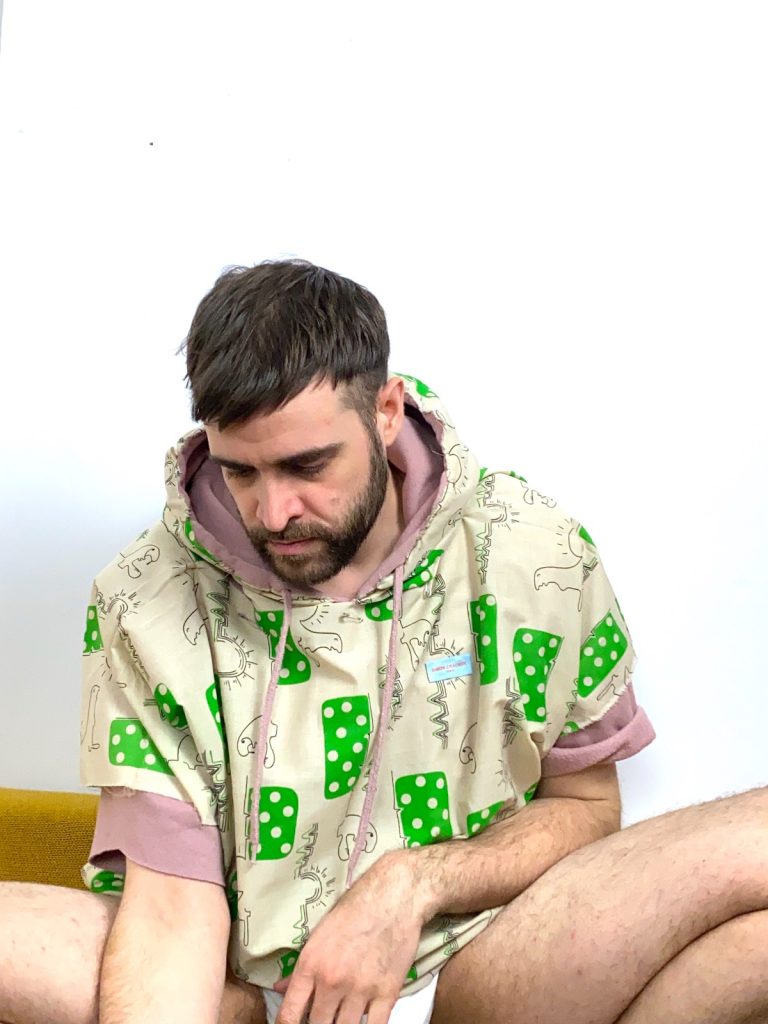
Absolute question: Simon Cracker, the name, where did it come out from?
Everyone thinks it’s about the crackers, the snack. I actually like them a lot and I mean them the japanese way, which includes everything you eat at tea time. It’s usually this kind of crunchy food, but not only. Contrasts in consistency and flavors. But, as a matter of fact, the former meaning was Simon the cracker, the destroyer, the one who takes useless stuff, dismantles it and creates something useful.
Can you reveal any secrets about Simon Cracker next collection?
Given that I have no intention of producing anything new, I can reveal that in 2021 I will dig into my archives and create from those. Rolls of fabrics from my previous collections will show up in a new guise; I’m trying to paint them, overthrow and paint them again… that’s it, I don’t even want to buy a single cotton thread for the new collection because I already have stuff.
This must be my own challenge. If something isn’t working out, I will disassemble and reassemble it until something interesting shows up. And because it is my challenge, I believe in it even more.

